#w.analysis
Explore tagged Tumblr posts
Text
I’m a fan of how Wonder Egg Priority takes the stance that being a bystander (i.e. “seeing no evil”) automatically means siding with the oppressor.

If you’re not actively fighting against this unjust system that allows the abuse of young girls, you’re part of the problem; you’ve assimilated said system’s values, decided that it’s okay that these girls are being abused. You’re the Seeno evil. You’re the enemy, and you can be cut down along with the Wonder Killer. And that’s why Ai feels so guilty about what happened to Koito; she feels like she betrayed Koito by being a bystander to her abuse.
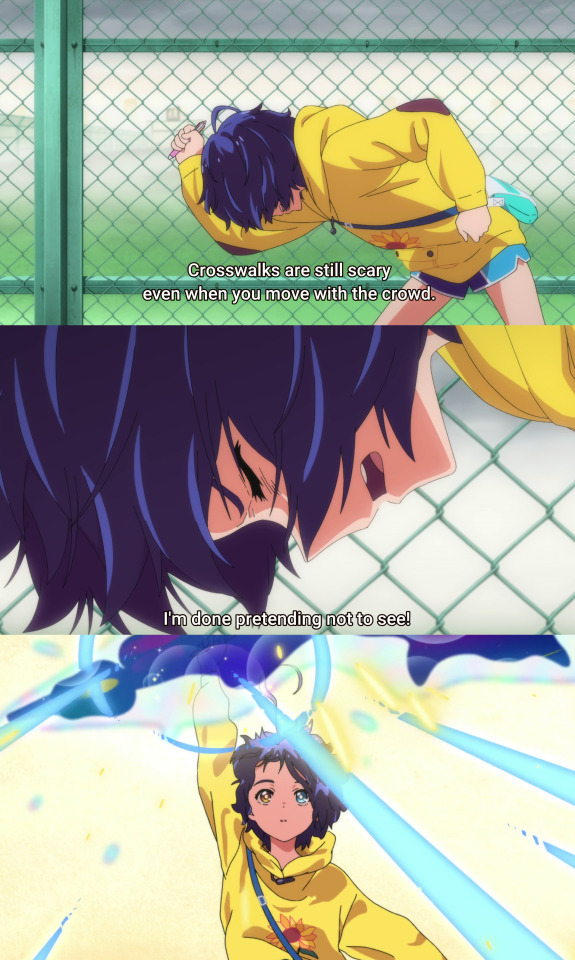
And it’s only when Ai makes up her mind that she’s done pretending to not see the absolute injustice of the world around her, done walking with the crowd, done being passive, that her pen transforms into a weapon. Only when she chooses to stop being a bystander can she oppose this system built on passive acceptance.
712 notes
·
View notes
Text
Wonder Egg Priority Episode 4: Boys’ and Girls’ Suicides Do Mean Different Things (But Not in the Way the Mannequins Want You to Think!)

So, let’s talk about this for a second. After I got over my initial knee-jerk reaction, I realized I wasn’t sure how to make sense of exactly what the mannequins were arguing for here. So let me rephrase their statements to make the argumentative structure more explicit: Because men are goal-oriented and women are not, because women are emotion-oriented and men are not, and because women are impulsive and easily influenced by others’ voices and men are not, boys’ and girls’ suicides mean different things – girls are more easily “tempted” by death, and therefore, more likely to require saving when they inevitably regret their suicide. While Wonder Egg Priority, so far, seems to agree with the vague version of the mannequins’ conclusion, namely that boys’ and girl’s suicides mean different things, it refutes the gender-essentialist logic through which that conclusion was derived.
The mannequins choose a decidedly gender essentialist approach in explaining the difference between girls’ and boy’s suicides; they argue that the suicides are different because of some immutable characteristic of their mental hard wiring (in this case, impulsivity, emotionality, and influenceability). Obviously, this is a load of bull, and Wonder Egg Priority knows it. The mannequins are not exactly characters we’re supposed to trust, seeing that they’re running a business that is literally based on letting these kids put themselves in mortal danger. As faceless adult men, they parrot and possibly represent the systems that force these girls to continue to be subjected to physical and emotional trauma (it’s probably more complicated than this, but four episodes in, it’s hard to say more). So, we’re probably supposed to take what they say with great skepticism. Also, the director, Shin Wakabayashi, has recently said that in response to these lines, Neiru was originally going to object, “When it comes to their brains, boys and girls are also the same,” (which unfortunately is not exactly true and is somewhat of an oversimplification, but the sentiment is there). While that line ultimately did not make it in, Neiru does reply with a confused and somewhat indignant, “What?!”, a reaction that gets the message across. Neiru is not a fan of gender essentialism, and as a (more) sympathetic character, we’re supposed to agree with her.
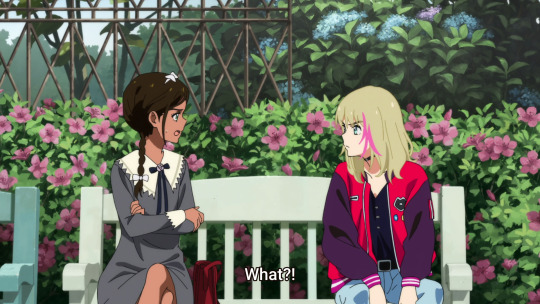
That is, the differences between boys and girls is not something inherent to their biology or character, but something constructed by culture and experience. This rejection of gender-essentialism is apparent in Wonder Egg Priority’s narrative, which takes a more sociocultural perspective on the difference between boys’ and girls’ suicides. It says, well of course boys’ and and girl’s suicides don’t mean the same thing, that’s the whole reason why we’re delving into the experiences specific to being a girl (cis or trans) or AFAB in this world – to show you how girls’ suicides are influenced by systems of oppression perpetuated by those in power (ie. the adult, in this specific anime).
And all the suicides we’ve seen up until now tie into that somehow. For instance, Koito is bullied by her female classmates who think that Sawaki is giving her special treatment. This is a narrative that comes up over and over again, in real life as well: that if a young girl is being given attention from an older man, then it’s her fault – that she must want it, or at least enjoy it somehow, and that it signifies a virtue (eg. maturity or beauty) on her part. And if Koito is actually being given such treatment by Sawaki, an adult man in a position of power over her, that is incredibly predatory.

And we all know that child sexual abuse is something that overwhelmingly affects girls, with one out of nine experiencing it before the age of 18, as opposed to one out of 53 boys (Finkelhor et al., 2014). Regardless of whether Sawaki was actually abusing Koito or if the students only thought that he was, Koito’s trauma is ultimately the result of this romanticized “love between a young girl and adult man, but not because the man is predatory, but because the girl has some enviable virtue that makes her desirable” narrative. Similarly, in episode 2, Minami’s suicide is driven by ideas related to discipline and body image in sports, which while not necessarily specific to female and AFAB athletes, is framed in an AFAB-specific way. For instance, take the pressure on Minami to “maintain her figure”. Certainly, male athletes also face a similar pressure, but we know that AFAB and (cis and trans) female bodies are subject to closer scrutiny and criticism. We know that young girls are more likely to suffer from eating disorders. And Wonder Egg Priority situates Minami’s experience as decidedly “about” AFAB experience when her coach accuses her change of figure due to her period as a character failing on her part.

Likewise, episode 3 delves into suicides related to “stan” culture, this fervent dedication to celebrities that is overwhelmingly associated to teenage girls. And Miwa’s story, in episode 4, explicitly shows how society responds to sexual assault. When Miwa does have the courage to speak up about her assault, she’s instantly reprimanded by basically everyone around her. Her father is fired because her abuser was an executive of his company. Her mother asks her why she couldn’t just bear with it, telling her that her abuser chose her because she was cute, as if that’s supposed to make her feel better about it. Wonder Egg Priority shows that this sort of abuse is a systemic problem, a set of rules and norms deeply engrained in a society and upheld by all adults, regardless of gender, social status, or closeness (to the victim). Wonder Egg Priority says that, yes, girls’ and boys’ suicides have different meanings, but it’s not due to some inherent difference between the two, but the hostile environment in which these girls grow up. Girls are not more easily “tempted” by death, they just have more societal bullshit to deal with.
But Wonder Egg Priority goes further than just showcasing how girls’ (and AFAB) experiences are shaped by sociocultural factors. The story also disproves the supposedly dichotomous characteristics that the mannequins use to differentiate girls and boys (i.e. influenceability/independence, impulsivity/deliberation, emotion-orientation/goal-orientation). If the mannequins are indeed correct, and that girls are just influenceable, impulsive, and emotional, you’d expect the girls in the story to be to be like such too. Except, they aren’t. Rather, they’re a mix of both/all characteristics. This show says that, certainly, girls can be suggestible, but they’re also capable of thinking for themselves. For instance, when Momoe asserts her own identity as a girl at the end of episode four, she rejects the words of those around her who insisted that she isn’t a girl. If she were as suggestible as the mannequins believe her to be, that would never have happened – she would have just continued believing that she wasn’t girl “enough”. But, she doesn’t because she is equally capable of making her own judgements. Likewise, Wonder Egg Priority shows that girls can be impulsive, but they can also be deliberate and pre-mediating. When Miwa tricks her Wonder Killer into groping her to create an opening for Momoe to defeat it, she’s not doing it out of impulse – it’s a pre-mediated and deliberate choice unto a goal. And Wonder Egg Priority continues, girls can be equally emotion oriented and goal oriented. Sure, the main girls are fighting because they have the goal of bringing their loved ones back to life, but those goals are motivated by a large range of emotions, from guilt to anger, grief, compassion, and love.
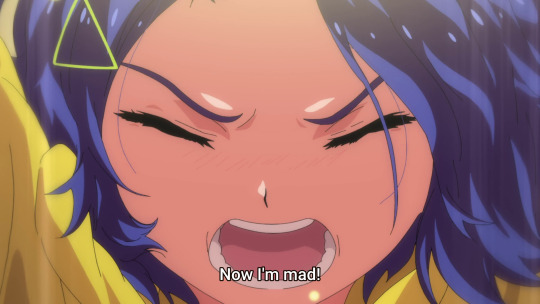
Being emotion-driven doesn’t mean you’re not goal-driven, and vice versa. In fact, in this case, being emotional drives these girls toward their goals. In other words, none of these traits that the mannequins listed are either “girl traits” or “boy traits”. Being one does not mean you can’t be the other, even if they seem dichotomous at first. Wonder Egg Priority’s diverse cast of multi-dimensional female characters allows it to undermine the mannequins’ conceptualization of gendered roles, refuting the idea that these (or any) character traits should be consider gendered at all.
As an underdeveloped side thought, I think Wonder Egg Priority’s blurring of gendered roles is also well-reflected in its style. There’s been a lot of talk about whether Wonder Egg Priority constitutes a magical girl series, and I think that’s an interesting question deserving of its own essay. Certainly, it does follow the basic formula of the magical girl story: a teenage heroine ensemble wielding magical weapons saves the day. But it also throws out a lot of the conventions you’d expect of a magical girl story – both aesthetically and narratively. Aesthetically, it’s probably missing the component that most would consider the thing that makes an anime a magical girl anime: the full body transformation sequence, complete with the sparkles and the costume and all that. Narratively, the girls are also not really magical girl protagonist material – they’ve got a fair share of flaws, have done some pretty awful things (looking at Kawai in particular; I still love you though), and aren’t exactly the endlessly self-sacrificing heroines you’d expect from a typical magical girl story. On the other hand, the anime also borrows a lot from shonen battle anime. We get these dynamic, well choreographed action sequences full of horror and gore, the focus on the importance of camaraderie between allies (or “nakama”, as shonen anime would call it) exemplified through all the bonding between the main girls during their downtime, and in the necessary co-operation to bring down the Wonder Killers. That said, this anime is not a shonen; the characters, types of conflicts, and themes are quite different from those that you’d find in a typical shonen. The bleeding together of the shonen genre and the magical girl genre, at the very least (and I say this because I think it does way more than just that), reflects Wonder Egg Priority’s interest in rebelling against conventional narratives about girlhood and gender.
#wonder egg priority#wonder egg priority analysis#wep#w.writing#my writing#anime analysis#analysis#anime#w.analysis
529 notes
·
View notes
Text
Burning as a Motif for Humanity in Violet Evergarden
I think, when watching Violet Evergarden, most of us picked up on fire as a motif for Violet’s trauma – the violence and destruction she witnessed in the war, and the violence and destruction she engendered with her own hands. I’m not going to go into this too much because it’s all pretty self-explanatory, if not trite, but here are some quick examples of fire as a motif for her trauma just to lay the groundwork for the rest of the essay:
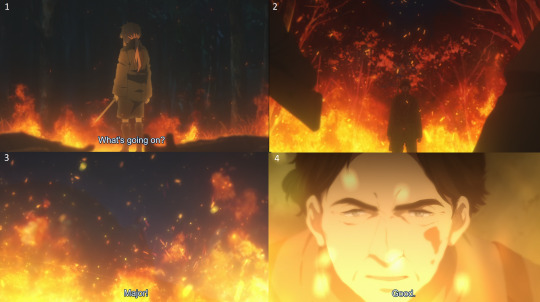
In frame 1 (episode 8), Violet draws first blood on the battlefield, and the once contained fire from the felled soldiers’ lanterns spread quickly through the forest, a symbol for how one small act of violence can cascade into large scale destruction. In frame 2, Gilbert stares at the carnage in front of him, horrified. In frame 3, the major is shot, and all we get to see is a screen of flames. In frame 4 (episode 12), Merkulov stares into a fire as he schemes about re-kindling the war.
I want to follow this (well trodden) opinion up with a more encompassing statement. That is, fire, in Violet Evergarden, is not limited to representing the destructive power of violence and trauma. Instead, it is a motif for humanity itself – an embodiment of the full range of experiences and emotions that make us human.
To show this, I’m going to start off at the beginning of Violet’s journey, focusing on how her disconnect (from herself as well as others) is illustrated in episode one. For instance, her initial struggle to move her now mechanical arms as she sits in her hospital bed in the opening sequence is an excellent embodiment of her dissociation from her own body and lack of agency. I want to, however, focus on two scenes that are particularly relevant for our discussion:
First, the scene where Violet spills tea on her hand:

And second, the scene where Hodgins insists that Violet is burning:

These scenes are similar: in both, someone asserts that Violet must be in pain, specifically due to burning, and in both, Violet rejects that statement. In the first, however, that burning is physical. And in the second, that burning is emotional. Regardless, Violet is so removed from her own body that she is incapable of feeling either. Her mechanical hand is therefore an embodiment of her inhumanity (ie. her “dollness” or “weapon-ness”). Like her, it is cold, mechanical, insensitive, without life or agency. After all, up until now, all she’s been doing is killing on command, without the ability to think for herself, experience her own pain, or sympathize with her victims’ pain.

When the screen shows that Hodgins is indeed correct, that Violet is literally on fire (frame 1), that fire is depicted with restraint. Flames engulfs Violet’s body, but those flames are from a streetlamp enclosed in glass. It is controlled and distant. This encapsulates Violet’s current state; she is literally on fire, but that fire is so compartmentalized and suppressed, and she is so far removed from her own experience, that she is incapable of feeling it.
In frame 2, we are viewing Violet in a flashback, from Hodgin’s point of view. Although we’re offered a close up shot of her bloodied hands, we see, about two cuts later, that Hodgin is actually observing Violet from afar (frame 2.5). This distance demonstrates that he cannot bring himself to reach out to her, something that Hodgin confesses he feels guilty about literally 5 seconds later. They were, at that point in time, and perhaps even now, unable to connect.
In frames 3 and 4, Hodgin is speaking again. We get this super far shot of Violet’s body. The camera is straight on, objective, and unfeeling. This unsympathetic framing has two functions. First, it distances us from Violet. Our inability to see the details on her face and her relatively neutral body language gives us, the audience, no real way inidication her thoughts. Second, it distances Violet from herself. As someone who experiences dissociative symptoms from PTSD, this is a very poignant way of framing what it feels like to be removed from your own experience. Hodgin’s line, “You’ll understand what I’m saying one day. And, for the first time, you’ll notice all your burn scars,” further drives home the sense that Violet is completely estranged from herself. It almost feels like we are looking at her, from her own detached point of view.
We’re going to move on now, but we’ll get back to these frames later in the analysis, so hold onto them.
Throughout Violet’s journey, fire comes up again and again. Specifically, it shows up in moments of emotional intimacy, connection, and healing. Let’s see what I mean by this:

I have here a collection of moments that all occur at the same narrative point in their respective mini-stories: the moment where one character reaches out to another, sympathizes with them, and literally pulls them of their darkness. For example, frame 1 (episode 3) shows Violet bringing a letter from Luculia to her brother. It expresses Luculia’s gratitude and love for him, and ultimately mends their relationship. In frame 2 (episode 4), Violet and Iris share a moment of emotional intimacy and connection, which is the beginning of Iris’ story’s resolution. In frame 3 (episode 9), Violet’s suicidal despondency is interrupted by the mailman, bringing her a heartwarming letter from all her friends. In frame 4 (episode 11), Violet comforts a dying solder by a fireplace.

It’s not that other modes of lighting do not exist – modern looking lamps show up repeatedly in the show. Even Iris’ rural family has them, so I can reasonably assume that, no, the above moments do not all coincidentally use lamps because that’s all there is in this universe; the usage of fire during moments of catharsis is deliberate, and establishes that fire can also bring hope, kindness, and love.
Now that we’ve explored the dual nature of fire as both destructive/constructive, painful/cathartic, let’s go onto the thesis of my essay. Why do I say that being on fire is to be human? Let’s go back to the scene where Hodgin tells Violet she’s on fire (episode 1, on the left), and compare it to the scene where Violet finally realizes that Hodgin was right and that she is on fire (episode 7, on the right):

In these sequences, there is a notable shift in framing and perspective. In frame 1b, we finally get to see Violet’s blood-stained hands from her point of view, as opposed to from Hodgin’s point of view in 1a. Violet becomes aware of her past as an actual agent choosing to kill, shown through the first-person point of view. Similarly, the medium, straight on shot of Violet looking down at her hands (frame 2a) is replaced with an intimate first-person, close-up view (frame 2b). In shots 3a and 3b, the difference in framing is most pronounced. In 3a, we get this straight on, long shot. In frame 3b, the camera’s detachment is replaced by a claustrophobic closeness. While this framing does an excellent job at conveying the panicked feeling of “everything crashing down all at once”, it also demonstrates Violet’s new-found awareness of herself. While before, the camera was used to alienate, now it is used to create a sense of painful awareness and intimacy.
These series of shots are the first in the entire show, I believe, of Violet's body from her own point of view. Their co-incidence with her awakening self-awareness characterizes the state of “being in one’s body” as a precondition to self-connection, or more specifically, to Violet’s understanding of herself as neither a weapon nor a doll, but as a human. Correspondingly, this pivotal moment serves as a catalyst for her subsequent emotional development. From this episode on towards the finale, we’re launched into a heart wrenching sequence of events: Violet’s desperate grieving for Gilbert’s apparent death, her attempted suicide driven by newfound grief, and most importantly, Violet receiving her first written letter, an act that is strongly representative of genuine human connection. Following these events, Violet’s emotional connection to both herself and others only continues to grow; during her two final jobs of the story, she breaks down crying in response to the suffering of her clients, demonstrating a level of compassion—if not empathy—that she seems to have never been able to tap into before.
At the same time, Violet acquires a new sense of agency, making plot-driving decisions that no longer require other characters’ validations. Most poignantly, in episode 12, she chooses to stay on the train to fight Merkulov, explicitly going against Dietfried’s order for her to leave. Her reason?
She doesn’t want anyone to die anymore.
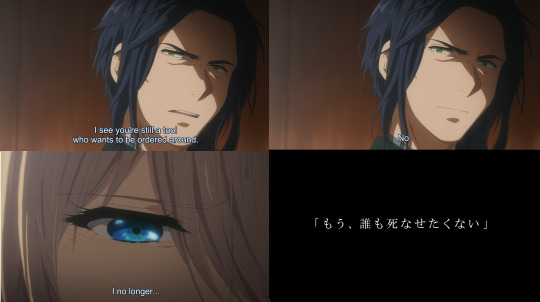
And it’s this moment, for me, that consolidated her as a character with true agency. Up until now, all her major decisions have been framed in relation to Gilbert: she killed in the war because Gilbert ordered her to, and she became an Auto Memories Doll because she wanted to understand Gilbert’s enigmatic “I love you”. Now, however, her motivation is purely her own—she fights, simply because she doesn’t want anyone else to die. It’s a line implies an intimate knowledge of loss. It’s a sentiment motivated by compassion. It’s a raw and extraordinarily human thing to say.
When Violet embarks on her journey to decipher Gilbert’s love, she is devoid of many traits we consider inherent and possibly even unique to being human—suffering, compassion, altruism, love, agency, and the interplay between them. As an Auto Memories Doll, she learns to live, experiencing all these emotions she had never had the luxury to experience before, and we quickly realize that she cannot know what love is without simultaneously wrestling with her trauma. She learns that yes, sometimes the fire destroys and sometimes it burns, but sometimes it thaws too, and you cannot have one without the other. You cannot choose what the fire does to you; you cannot choose what you want to feel. Thus, to be on fire is to know the anguish of its destruction, but it is also, and more importantly, to know the catharsis of human connection, to be the warm flame that pulls someone else out of the dark, to be pulled out of the dark yourself. To be on fire is to be human.
#violet evergarden#violet evergarden analysis#anime analysis#anime#anime essay#anime meta#violet evergarden meta#analysis#w.writing#w.analysis
55 notes
·
View notes